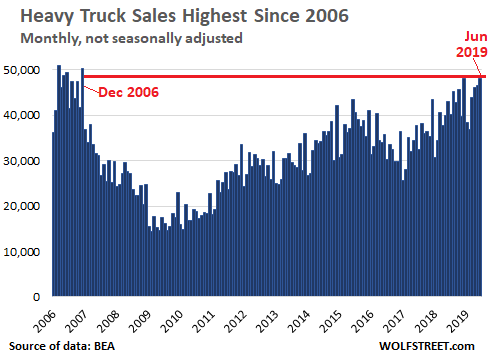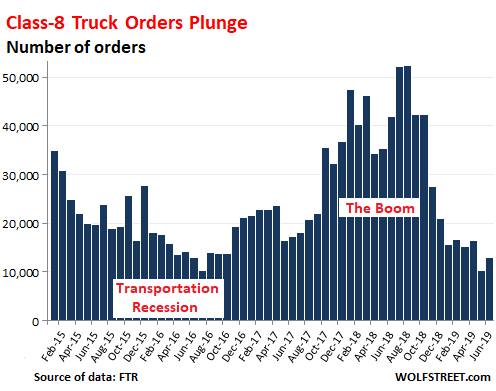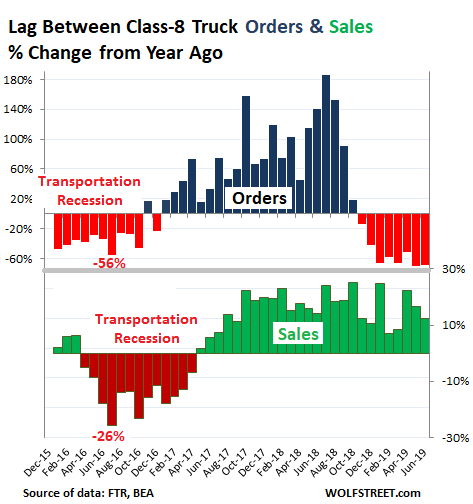“Orders” of Heavy Trucks Collapsed by 70% but “Sales” Rose to Highest Level Since 2006: There’s a Lag. And Sales Are Next
Now there is this phenomenon: Orders for Class 8 trucks – the heavy trucks that move a big part of the goods across the US – have collapsed by about 70% in May and June compared to a year earlier, to just over 10,000 truck-orders per month, the lowest in years. But sales of Class 8 trucks in June, as measured by deliveries to trucking companies and truckers, reached 48,168 units, the highest since 2006. So what gives?
This chart shows the number of sales of heavy trucks through June as reported by the Bureau of Economic Analysis (not seasonally adjusted):

Many of the trucks that were delivered in June and earlier this year were ordered in 2018, which was a banner year for truck orders, that soared to all-time records in July and August with over 52,000 orders each month, according to FTR Transportation Intelligence. These orders created a record backlog at manufactures, already operating at capacity, which lengthened the delays in getting the trucks built. These delays led trucking companies to speed up their orders to get them into the system before the others, which further increased orders, backlogs, and delays. And now these orders are being delivered at a near-record pace.
But orders for Class 8 trucks started declining late last year. In December last year, shipments of goods across all modes of transportation (truck, rail, barge, and air) began to decline. And the capacity crunch dissipated and turned into over-capacity, which put downward pressure on spot rates for truckers.
Orders for Class 8 trucks have now plunged eight months in a row and have hit the lows of the 2015-2016 “transportation recession,” to just barely above 10,000 units a month:

So there is no mystery: The big sales numbers being reported currently are largely based on orders that truck manufacturers received last year during the capacity crunch and the ensuing ordering panic. Now, truck manufacturers and their suppliers are working through their backlogs, and these backlogs, given the plunge in orders, are shrinking rapidly.
These are all 2019 model-year trucks that are being delivered now. Truck manufacturers are in the process of opening up orders for the 2020-model year.
The last cyclical sales peak occurred in mid-2015 at 40,000 trucks per month. At the time, orders had been declining for months. Sales then dropped 26%. Nurtured by the backlog at the beginning of the “transportation recession,” manufacturers kept up production and sales for a while before it hit home, leading to layoffs at truck manufacturers and engine and component suppliers.
The lag between orders and sales continued on the upswing, though the lag was shorter, with orders picking up first in late 2016. By February 2017, sales started picking up, as lead times had been whittled down due to lack of orders in 2015 and 2016. Now the same process is beginning to happen, but more extreme.
The chart below shows orders and sales, juxtaposed, in terms of the percent change each month from the same month in the prior year. Sales are less volatile than orders because sales have a battery, so to speak, namely the backlog that gets charged up during good times and that manufacturers are able to draw on during tough times for a number of months, when they also cut capacity by laying off workers. That peak year-over-year decline in sales during the transportation recession was in July 2016 at 26%, while orders plunged by over 50%:

So far, so good for truck manufacturers: Peterbilt and Kenworth of Paccar [PCAR]; Navistar International [NAV]; Freightliner and Western Star of Daimler; and Mack Trucks and Volvo Trucks of Volvo Group. The backlog from the pile of orders in 2018 for Class 8 trucks is still feeding them, and they’re still manufacturing at capacity.
For now, the hope still is that orders for the 2020 model year will start flooding the manufacturers. But trucking companies are adding capacity on a daily basis in form of these new trucks that were ordered last year and that are being delivered now – the “sales” of heavy trucks that have hit the highest level since 2006.
And given this rapid addition to capacity alongside the current decline in shipments of goods by all modes of transportation, and the downward pressure on spot rates and contract rates, trucking companies have become careful with their ordering strategies, and manufacturers will soon be confronted with the cyclical sales decline that is already preprogrammed by the plunge in orders and the decline in the backlog.
After truck manufacturers eat up their backlogs, then what? Read... Trucking is Infamously Cyclical, But This is a Tad Extreme
Enjoy reading WOLF STREET and want to support it? You can donate. I appreciate it immensely. Click on the mug to find out how:
![]()


I am reminded of the old VH-1 rockumentaries…
“And then the music stopped.”
I have spent my life in manufacturing and this phenomenon can be easily explained. When manufacturing from a long term fixed book a properly managed factory can increase its production compared to an environment where there are more rush orders ( to preferred clients etc.) or spec changes as would be the case if sales were hot. The locked in order book allows the truck factories to make sure parts arrive on time, like models can be batched and changes or delays eliminated. They are also motivated to deliver orders ( and convert them to sales) as quickly as possible and avoid the chance the customer will back out or go broke.
Backlogs are being filled, and the economy is heating up? It’s also apt to put a blush on GDP numbers but Fed can look at new orders and drop interest rates and that will spur new orders. It’s all good.
Tell that to the former Deutschebank employees that got their walking papers today
When you work for an illegal operation, you have to calculate in factors like getting raided and having to go find another illegal operation to work for.
And those were good paying jobs. ouch!
People way overestimate the impact of the Fed on the real economy. A 25 basis point cut barely means anything to companies that are up to their gills in debt. Now for Wall Street it is really important as investors will no longer have the option of fix rate investing and they decide to go into risk assets.
And production efficiency goes up with a backlog of base items!
I was looking at that chart last night and also saw how trucks sales boom before a recession. Maybe that indicates that animal spirits get excited and greedy at the tip of a market, and the animals fail to see the risk of buying new toys at a point where the economy is slowing? That type of thinking should fit well when the Fed doesn’t lower rates this month, and trump and the markets freak out with temper tantrums and then yields go down, and Stealth Stimulus helps stimulate housing, pumping that bubble an also making it easier to buy big trucks and so on and so forth and America is Great Again … bawhahaha
The economy has slowed a lot in last 18 months imo. I do think the Fed went too far
For sure the rates market does
The economic bump was caused by the tax cut and fiscal stimulus of 2018, you can always get a bump by deficit spending. Now with a equal playing field the y/y numbers don’t look so good. Also keep in mind that in order to pass the tax cut under budget reconciliation some of that stimulus is going to be reversed over the coming years creating a drag on the economy. Look mom I spent 1.5 trillion in debt and got 3 good quarters of growth. Winning.
First quarter GDP growth was high.
Artificial intelligence might route deliveries more efficiently saving fuel, labor and vehicle costs.
I was just thinking about how artificial intelligence needs to visit my dumb smart phone. It’s taking it’s sweet time.
I too think that AI could be the big factor here… Self driving trucks are around the bent (some mines I know off are retrofitting old hauling trucks to be automatic.
The truck drivers will need training in data science, to retool…
We’re in a recession but nobody will admit it, especially not the government and Fed. When everyone wakes up the masses will ask why nobody warned them while the 1% runs off with more riches at our expense.
///
Well, recessions only happen after elections, so we can expect the crisis to start sometime beginning 2020…because there is no better argument to direct policy makers to act on your behalf like a collapsing system…kind of a economic blackmail.
///
Agreed, we are in a forcefully deferred recession.
///
How much of the decline is due to EPA mandated emissions that now reduce fuel economy and frankly do not have much dependability?
Diesel exhaust fluid particulate systems are horrible to work on and have issues. Even off road equipment is being fitted with these systems that do not work well.
Several people in the industry have said they will rebuild older trucks and equipment to keep from moving to the new mandated emissions system equipped units.